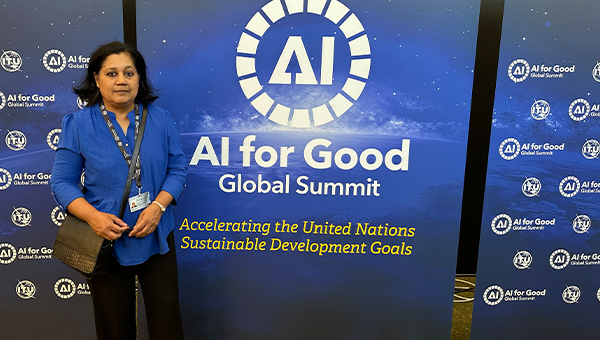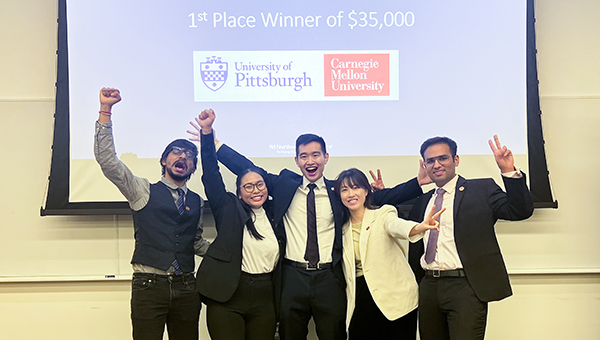Revolutionizing Healthcare: Harnessing Artificial Intelligence for Better Patient Care
By Jennifer Monahan
In the ever-evolving landscape of healthcare, technology has become an indispensable ally. Electronic records let physicians access patient information more easily. Phone apps and web-based tools allow users to schedule doctor’s appointments and check test results online. The Covid pandemic illustrated how tele-health appointments can be a crucial tool in connecting patients with doctors.
One of the most promising – and fraught – advancements is the integration of artificial intelligence (AI) into the healthcare sector. The potential intersections of AI, machine learning/deep learning (ML/DL), and health care are many. Rema Padman, Trustees Professor of Management Science and Healthcare Informatics at Heinz College of Information Systems and Public Policy, has been focusing lately on three particular areas of study. She recently sat down to share some of her research and to discuss the opportunities and challenges of AI in health care.
Empowering Patients through Digital Solutions
One key application of AI in health care is the development of digital solutions that enhance health literacy – a significant but understudied challenge in healthcare delivery.
“A health-literate patient is really an engaged patient, and an engaged patient has better outcomes,” Padman explained. “So how can we leverage these technologies and analytics to create solutions that would be informative and engaging for people to access, and simultaneously improve their knowledge about managing their conditions?”
Digital therapeutics – using software and evidence-based insights to build digital solutions that aim to bring about behavior change – is one answer. When a doctor diagnoses a patient with an illness, the treatment often includes a prescription for medication. With digital therapeutics, the doctor might also prescribe a multi-media-rich video that explains the condition and another that helps the patient understand what the medication is, exactly when and how they should take it, and what the side effects might be. The videos are already out there.
“We found that there are several million videos on health-related topics alone on YouTube,” Padman said.
Some of that content is created by academic medical centers and large healthcare organizations like University of Pittsburgh Medical Center (UPMC), the Mayo Clinic, and Johns Hopkins University. No problem.
Some of it is created by lay people with no medical training, but strong (and oftentimes erroneous) opinions about a particular illness or medical treatment. That’s a problem. Some of the videos, even from credible sources, might not take into consideration the specific needs of a particular population of people – such as dietary customs, nutritional needs, age, race, or gender. That can also be a problem. Asking an already overtaxed doctor to sort through thousands of videos about treating a urinary tract infection to find the best one for a particular patient is unrealistic.
That’s where AI can help.
“What we’re doing is using AI, ML/DL, and natural language processing to curate these videos,” Padman said. “We are asking questions: Does the video contain accurate medical information? Is it understandable by the layperson? Is it at an eighth grade or a fifth-grade reading level? Is it laid out well? Is it audible? Is it short - under five minutes? Does it provide some kind of actionable guidance? Is it trustworthy? Is it fair and unbiased? Is it inclusive and representative?”

AI for Global Good
Professor Rema Padman shared insights about the use of AI in health care at an ML workshop in Geneva, Switzerland. The United Nations event accelerates Sustainable Development Goals.
The AI model Padman is helping to develop filters all that video content to find a shortlist of videos that fit these criteria. With that curated list, the medical practice can conduct a final review for accuracy and timeliness of content, and determine a few of the most pertinent videos about UTIs (or heart disease, or strep throat, or any other illness) that best fit their patient populations and keep them handy to prescribe when needed.
Padman is one of the authors – an advisory group of 25 members including physicians, thought leaders, and technologists from around the world – of a recent publication in the National Academy of Medicine’s NAM Perspectives who have created criteria for evaluating the credibility of health-related online social media content produced by non-profit organizations, for-profit organizations, and individuals. The achievement is noteworthy because having formal, agreed-upon standards in place is a key step in establishing trustworthiness.
Identifying credible sources is one challenge. Inclusivity and representation are similarly essential components.
Currently, much of the content deemed reliable is created by domain experts at healthcare organizations. While women have entered these ranks, few of the health-related videos are narrated by women or people of color. Padman highlighted what that discrepancy might mean for patients as a “rapport” problem.
As a person of South Asian descent herself, considering a patient who might be diagnosed with diabetes, Padman said that hearing information from a diabetes-educator, for example, who is familiar with South Asian cultural norms and food habits could help improve adherence to recommendations.
“When I see videos that reference five food groups and so on, that's not aligned with the way my meals are made,” Padman said. “And studies have shown that, especially among African American populations, Latin populations, and others, rapport is very important for uptake of guidelines, prescriptions, and therapies.”
When someone’s health is at stake, inclusivity and fairness can be matters of life and death. The video prescriptions are a helpful tool, but not a perfect antidote.
“We cannot just blindly apply AI/ML and say the resulting videos are fully curated when it doesn't really meet the health-education needs of the population,” Padman explained. Explicitly evaluating the videos to improve inclusivity is one way Padman is trying to address and mitigate potential biases.
Digital Vaccines: AI + Gamification for Pediatric Health Literacy
Digital therapeutics can work for children as well as adults. Padman and FriendsLearn, the gamified mobile platform developer, have created a digital vaccine and are collaborating with researchers from CMU, the University of Michigan, Johns Hopkins University, Hofstra University, and Voluntary Health Services in India to evaluate this mobile health gamified platform that incorporates the science and technology of neurocognitive training and implicit learning via AI-enabled immersive gaming.
It currently targets early childhood nutrition literacy, physical activity, and health-hygiene promotion in a fun and engaging way for kids; the project has the potential to expand to include other literacy needs such as mental health and wellness care. The goals are to improve healthy lifestyle knowledge, behavioral, and clinical outcomes. Like a traditional vaccine, digital vaccines are meant to prevent disease. The difference is digital vaccines work by orienting the brain toward healthy behaviors, rather than stimulating a physical reaction in the immune system.

fooya!
The fooya! app targets early childhood nutrition literacy, physical activity, and health-hygiene promotion in a fun and engaging way for kids.
Padman’s team did a randomized, controlled trial (RCT) with a low-resource school in India during the fall of 2022. Another RCT is underway with the UPMC Children's Hospital of Pittsburgh, focused on children with Type 1 diabetes. The results are promising, and the project has already garnered attention; the project won the 2022 Transformational Solutions – New Frontiers Award by the Financial Times and the World Bank's International Finance Corporation for pioneering deep tech breakthroughs with digital vaccines.
AI for Improved Chronic Disease Management
AI has the potential to be an invaluable tool in chronic disease monitoring and management. Risk assessment models enable healthcare providers to identify high-risk patients and tailor interventions accordingly, but the models also have ethical implications related to bias. Effective, unbiased models depend on large quantities of comprehensive, unbiased data. If the data source – say, one million electronic health records – lacks information about Black women with heart disease, the model could produce an inaccurate prediction of risk for that illness for a female Black patient.
Effective tools also depend on technologists to ask the right questions, to identify potential blind spots that could result in bias, and to design AI models that result in equitable healthcare solutions. It’s a tall order. CMU’s Block Center for Technology and Society was formed to consider issues such as this one. For an example of how Rayid Ghani, Distinguished Career Professor in the Machine Learning Department and the Heinz College of Information Systems and Public Policy, has used ML to predict risk equitably for lead poisoning in children, make sure to check out this article.
The benefits of developing equitable, transparent, safe, and secure AI models for risk prediction are worth the considerable cost and effort. Good information allows doctors to make the right prediction for the right individual at the right time – ultimately resulting in better outcomes for patients.
Reducing a physician’s cognitive workflow is another potential benefit of AI. Currently, during a 15-minute visit with a patient, the doctor is often trying simultaneously to transcribe notes, complete insurance checklists, review past electronic health notes, and listen to the patient’s concerns. An AI system that could address the insurance requirements, summarize the patient’s history, and highlight key aspects for the doctor to cover during the appointment would allow more time and cognitive bandwidth for the physician to listen to and focus on the patient. Padman and her colleagues have focused on combining AI and optimization to minimize the cognitive workload that physicians experience while placing orders in hospital information systems.
AI in Action: Interdisciplinary Team Triumphs
One concrete example of how AI can solve complex problems in health care is a recent project to match breast cancer patients with appropriate clinical trials, completed by graduate students at Carnegie Mellon University and the University of Pittsburgh. The interdisciplinary team of Alexander Chih-Chieh Chang, Yuwei Guo, Shiqi Liang, Katelin Lauren Rimando Avenir, Aditya Singh, Rabira Tusi, and Anirudh Vaidhyaa Venkatasubramanian included students from Pitt-CMU’s joint MD-Ph.D. program as well as CMU master’s-level students studying design, information systems, health care analytics, and business intelligence and data analytics. Padman served as their faculty mentor.
More than 80% of clinical trials struggle because of lack of patients. Among clinical trials that move forward, recruiting enough participants who fit the trial criteria and are representative of the larger population in terms of ethnicity and race is a significant challenge. The student team recently won first place and $35,000 in the Third Coast AI for Health Equity Bowl by developing a solution for these dilemmas. Their AIquitas (pronounced “eye-keet-us”) tool utilized ML algorithms that intelligently compare patient records with clinical trial language and then evaluate compatibility scores.

Team AIquitas
Members of the team celebrate after finishing first, earning a $35,000 award.
For all patients – and especially for people of color, because of the problematic history of unethical medical testing on racial minorities – having a trusting relationship with their physician is one important predictor in whether the patient might choose to participate in a clinical trial. With a tool like AIquitas, physicians would benefit from the efficiency and effectiveness of an automated trial-screening process, freeing up time that can be spent caring for and listening to patients. Patients would benefit from receiving personalized recommendations about which clinical trials are the best fit for them. Supported with such information, patients could more easily seek out trials directly if they wished.
The endgame is that every patient could better access clinical trials, regardless of their socioeconomic status and race. The team is in the process of publishing their work; they hope to pilot the tool at the University of Pittsburgh Medical Center (UPMC) and eventually bring it to market.
Optimizing Operations With AI
A third area where AI can be particularly effective is in streamlining operations within healthcare systems. Tasks such as scheduling or assigning patients to practice physicians could be accomplished efficiently with AI, if technologists could design the right parameters, ask the right questions, and use the right data.
Patient needs are complex and unique. For example, an otherwise healthy 20-year-old might require a quick appointment and prescription for antibiotics to address an infection. An 80-year-old with underlying health conditions or comorbidities would need more time and attention from the physician to provide effective treatment for that same infection.
“We really need to understand these clusters of patient pathways, different groups of patients requiring different sequences of activities, tasks, and needs,” explained Padman. “Once we understand the major categories of patients, then we can subsequently design efficient ways of tracking tasks and serving their healthcare needs.”
Intelligent models could improve the clinical workflow – what Padman calls the “upstream to downstream” patient and clinician experience, from the time a patient calls to make an appointment throughout the care and follow-up process – taking into account whether the patient requires a specialist, has a preferred physician, is already being treated by multiple doctors, etc.
An integrated and adaptive system that considers the unique characteristics of each patient has the potential greatly enhance the overall healthcare experience and outcomes.
Why Getting it Right Matters
“Health care touches everybody,” Padman said.
The integration of AI into health care holds immense promise for the future. From empowering patients of all ages, to assisting physicians with chronic disease management, to optimizing operations, AI has the potential to reshape healthcare delivery. The stakes are high to implement AI tools in a way that benefits all populations – and does not perpetuate existing inequalities.
“We have to think very deeply about these issues of accountability, ethics, liabilities, trustworthiness, and biases,” Padman said, “and of course, to always keep in mind underserved and disadvantaged populations.”
AI’s transformative potential must be harnessed ethically and equitably, ensuring inclusivity, privacy, and responsible use. As AI continues to evolve, we stand at the precipice of a new era in health care, where technology and human expertise converge to improve patient and societal outcomes and redefine the possibilities of modern medicine.